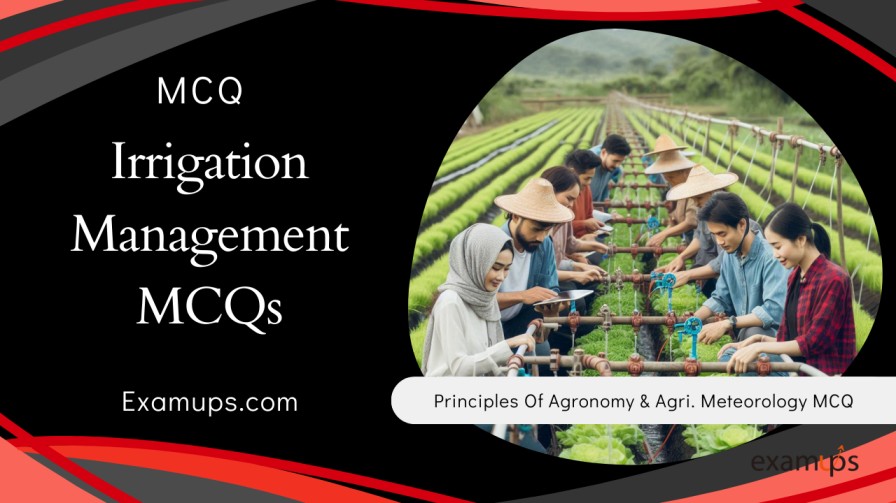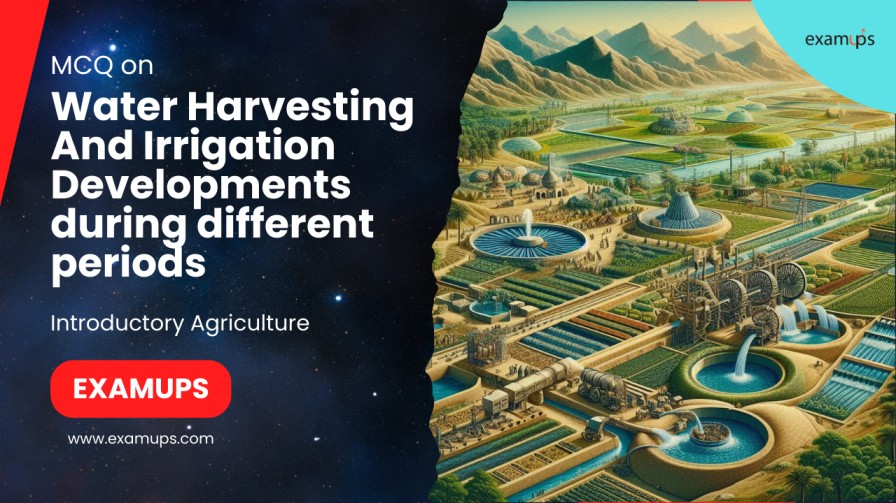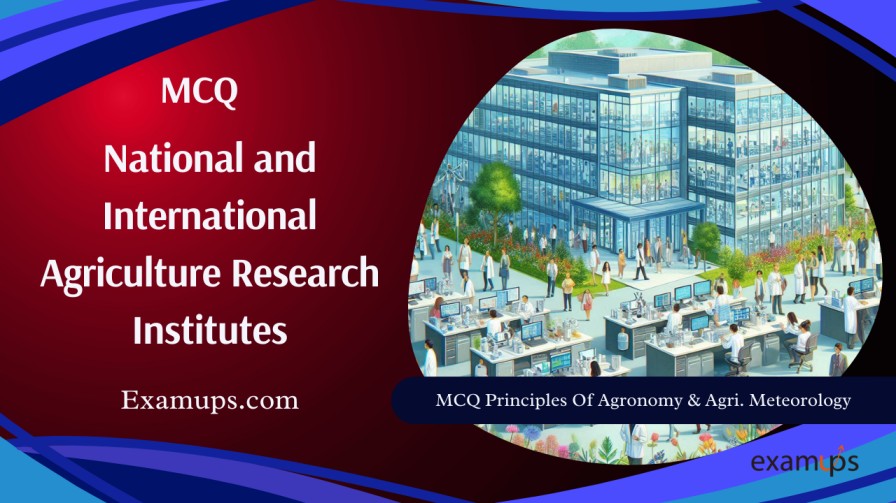Irrigation Management and Drainage MCQ for ICAR-JEF, ICAR-SRF, ICAR-NET, IBPS-AFO/SO, Pre-PG, BHU Pre-PG, IFFCO-AGT, CCI, FCI, B.sc, M.sc, etc.
Here are 20 multiple-choice questions (MCQs) with answers and explanations on Irrigation Management and Drainage:
Irrigation Management MCQs
Question 1:
What is the primary objective of irrigation in agriculture?
- A) To increase soil fertility
- B) To supply essential moisture for plant growth
- C) To create drainage systems
- D) To ensure even distribution of sunlight
Answer: B) To supply essential moisture for plant growth
Explanation: The primary goal of irrigation is to provide plants with the necessary water for growth, especially in areas with insufficient or irregular rainfall.
Question 2:
Which of the following is NOT an objective of irrigation?
- A) To ensure crop insurance against short spells of drought
- B) To dilute or wash out soluble salts
- C) To create soil erosion
- D) To provide favorable microclimates for crop growth
Answer: C) To create soil erosion
Explanation: Irrigation supports crop growth and productivity, while soil erosion is an undesirable outcome.
Question 3:
Which method of irrigation involves the distribution of water through small channels or furrows?
- A) Drip irrigation
- B) Check basin
- C) Corrugations
- D) Sprinkler system
Answer: C) Corrugations
Explanation: The corrugation method involves creating small furrows or channels to guide water efficiently to crops.
Question 4:
What is one of the advantages of drainage in agricultural systems?
- A) To prevent waterlogging
- B) To increase soil moisture
- C) To enhance soil erosion
- D) To create water reservoirs
Answer: A) To prevent waterlogging
Explanation: Drainage removes excess water from the soil, preventing waterlogging and ensuring better aeration for plant roots.
Question 5:
Which of the following is a common method to quantify the amount of irrigation water?
- A) Rain gauge
- B) Water meters
- C) Thermometers
- D) Soil probes
Answer: B) Water meters
Explanation: Water meters measure the amount of water flowing through irrigation systems, enabling accurate water management.
Question 6:
Which type of irrigation is best suited for conserving water by delivering it directly to the roots?
- A) Surface flooding
- B) Sprinkler irrigation
- C) Drip/trickle irrigation
- D) Boarder strip irrigation
Answer: C) Drip/trickle irrigation
Explanation: Drip irrigation delivers water directly to the root zone, minimizing water loss due to evaporation or runoff.
Question 7:
One of the objectives of irrigation is to “soften tillage pans.” What does this refer to?
- A) Reducing the hardness of soil layers that impede root growth
- B) Softening the soil for easier planting
- C) Increasing water retention in the soil
- D) Improving soil fertility
Answer: A) Reducing the hardness of soil layers that impede root growth
Explanation: Tillage pans are compacted soil layers that limit root penetration, and irrigation can help soften these layers, promoting better root development.
Question 8:
Which of the following irrigation methods is typically used in flat, uniform fields to irrigate large areas?
- A) Drip irrigation
- B) Flooding
- C) Ridge and furrow
- D) Sprinkler system
Answer: B) Flooding
Explanation: Flooding is used in flat, uniform fields where water is spread over large areas for uniform irrigation.
Question 9:
In the context of irrigation, what does the term “intensive cropping” refer to?
- A) Planting multiple crops in a single growing season
- B) Using extensive amounts of fertilizers
- C) Increasing the density of crops in a field
- D) Harvesting crops more frequently
Answer: A) Planting multiple crops in a single growing season
Explanation: Intensive cropping involves growing multiple crops within one growing season, requiring effective irrigation management.
Question 10:
What is the key advantage of using a sprinkler system for irrigation?
- A) It is highly water-efficient
- B) It can cover large areas with minimal labor
- C) It reduces soil erosion
- D) It allows for controlled water distribution in specific patterns
Answer: B) It can cover large areas with minimal labor
Explanation: Sprinkler systems efficiently irrigate large areas with less labor, which is beneficial for commercial farming.
Drainage Management MCQs
Question 11:
What is drainage in the context of agriculture?
- A) The process of removing excess water from the soil
- B) The addition of nutrients to the soil
- C) The creation of water reservoirs for irrigation
- D) The implementation of irrigation systems
Answer: A) The process of removing excess water from the soil
Explanation: Drainage involves removing excess water from the soil to prevent waterlogging and improve plant growth.
Question 12:
Which of the following is a common cause of waterlogging in agricultural fields?
- A) Intensive rains
- B) Low soil fertility
- C) Insufficient irrigation
- D) Lack of crop rotation
Answer: A) Intensive rains
Explanation: Heavy rains can saturate the soil, causing waterlogging if the soil cannot absorb or drain the excess water.
Question 13:
What is one of the effects of ill-drained conditions on crops?
- A) Enhanced root growth
- B) Restricted root growth
- C) Increased soil fertility
- D) Improved water retention
Answer: B) Restricted root growth
Explanation: Poor drainage leads to waterlogged soils, restricting root development and reducing plant health.
Question 14:
Which of the following is a potential benefit of proper drainage in agricultural systems?
- A) Increased soil salinity
- B) Improved soil ventilation
- C) Reduced soil fertility
- D) Increased soil erosion
Answer: B) Improved soil ventilation
Explanation: Proper drainage improves aeration by allowing air to reach plant roots, promoting healthy growth.
Question 15:
How can defective irrigation contribute to waterlogging?
- A) By providing insufficient water to crops
- B) By causing excess water accumulation in the soil
- C) By creating soil erosion
- D) By reducing water retention in the soil
Answer: B) By causing excess water accumulation in the soil
Explanation: Over-irrigation or poorly designed irrigation systems can result in excessive water buildup, leading to waterlogging.
Question 16:
What is the key difference between surface drainage and subsurface drainage?
- A) Surface drainage removes water from the soil surface, while subsurface drainage removes water from below the surface
- B) Surface drainage is used in dry climates, while subsurface drainage is used in wet climates
- C) Surface drainage is more cost-effective than subsurface drainage
- D) Subsurface drainage is used for irrigation, while surface drainage is used for water collection
Answer: A) Surface drainage removes water from the soil surface, while subsurface drainage removes water from below the surface
Explanation: Surface drainage removes excess water from the soil surface, while subsurface drainage deals with water below the surface.
Question 17:
Which of the following is a common method used for subsurface drainage in agricultural fields?
- A) Canals
- B) Trenches
- C) Drainage pipes or tiles
- D) Sprinkler systems
Answer: C) Drainage pipes or tiles
Explanation: Subsurface drainage systems use drainage pipes or tiles to remove water from below the soil surface.
Question 18:
What is a common negative effect of waterlogging on crops like maize or mustard?
- A) Restricted root growth and lodging
- B) Improved soil fertility
- C) Enhanced plant growth
- D) Increased resistance to pests
Answer: A) Restricted root growth and lodging
Explanation: Waterlogging restricts root development, which can cause lodging (plants falling over due to weak roots).
Question 19:
Why is mid-season drainage important for rice crops?
- A) To reduce waterlogging and allow the soil to breathe
- B) To increase soil fertility
- C) To enhance root growth
- D) To prevent over-irrigation
Answer: A) To reduce waterlogging and allow the soil to breathe
Explanation: Mid-season drainage allows soil to aerate, which is important for rice crop health.
Question 20:
How can proper drainage improve soil structure and decrease soil erosion?
- A) By promoting healthy root growth and reducing soil compaction
- B) By allowing more water retention in the soil
- C) By increasing soil salinity
- D) By creating drainage channels that lead to erosion
Answer: A) By promoting healthy root growth and reducing soil compaction
Explanation: Proper drainage improves soil structure and reduces compaction, which helps prevent erosion.ations.










